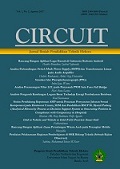Analisa Potensi Energi Angin dengan Distribusi Weibull Untuk Pembangkit Listrik Tenaga Bayu (PLTB) Banda Aceh
DOI:
https://doi.org/10.22373/crc.v1i1.1377Keywords:
renewable energy, PLTB, HybridAbstract
Energy needs in Indonesia in particular and the world in general continue to rise due to population growth, economic growth and energy consumption patterns themselves are constantly increasing. One of the fast growing renewable energy in the world today is wind energy. Wind energy is a renewable energy that is very flexible. In general, the utilization of wind power in Indonesia is less attention. Until 2004, the installed capacity of wind power utilization is only up to 0.5 MW from 9:29 GW potential. One method used to measure the wind energy potential of wind energy for electricity generation is by using the Weibull method. From the analysis that has been carried out by the method of Weibull can be concluded that the wind energy potential of wind energy for electricity generation in Banda Aceh does not meet the eligibility criteria.References
Daut M, Irwanto, Suwarno Y, M Irwan, N Gomesh, N S Ahmad. Potential of Wind Speed for Wind Power Generation In Perlis, Northern Malaysia. School of Electrical System Engineering, Universiti Malaysia Perlis (UniMAP), Malaysia. 2010.
Y Daryanto. Kajian Potensi angin Untuk Pembangkit Listrik Tenaga Bayu Neural Computing and Robotics. BALAI PPTAGG – UPT-LAGG. Yogyakarta. 2007.
A F Nelwan. Karakteristik Weibull Pltb Miangas. Jurusan Teknik Elektro. Universitas Sam Ratulangi -Manado-Indonesia.
R M Patel. Wind and Solar Power System. New York: CRC Press. 1999
Dedy Nugroho, Syariffuddin Mahmudsyah, Heri Suryoatmojo. Optimisasi Pembangkit Listrik Tenaga Bayu Dan Diesel Generator Menggunakan Software Homer. Jurusan Teknik Elektro. FTI – ITS.
Nurhalim. Studi Analisis Pemanfaatan Energi Angin Sebagai Pembangkit Hibrida. Program Studi Teknik Elektro Fakultas Teknik. Universitas Riau. 2007.
Downloads
Published
Issue
Section
License
Authors who publish in CIRCUIT: Jurnal Ilmiah Pendidikan Teknik Elektro agree to the following terms:
- Authors retain copyright and grant the journal right of first publication with the work licensed under a Creative Commons Attribution-ShareAlike 4.0 International License (CC BY-SA 4.0) that allows others to share and adapt the work with an acknowledgement of the authorship and initial publication in this journal
- Authors are able to enter into separate, additional contractual arrangements for the non-exclusive distribution of the journal's published version of the work (e.g., post it to an institutional repository or publish it in a book), with an acknowledgment of its initial publication in this journal.
- Authors are permitted and encouraged to post their work online (e.g., in institutional repositories or on their website) prior to and during the submission process, as it can lead to productive exchanges, as well as earlier and greater citation of published work. (See The Effect of Open Acces)

